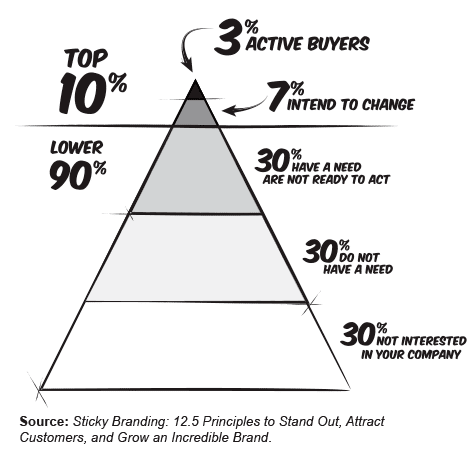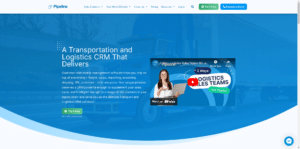What do most people think of salespeople?
It’s not good.
A recent survey from HubSpot Research, “found only 3% of people consider salespeople to be trustworthy.” Gallup’s annual rating of the honesty and ethics of various professions consistently ranks salespeople at the bottom — below members of Congress.
It gets worse.
Tom McMakin, author of the book, Never Say Sell, had this to say about salespeople.
“Most of us hate salespeople. They’re the bottom-feeders of commerce schooled in the art of deceit and manipulation. Think of The Wolf of Wall Street, Margin Call, and Glengarry Glen Ross. Was there a character in any of these movies who was anything other than craven and rapacious?”
Yikes.
Sales outreach is all but impossible with this attitude
Most salespeople know this.
When they begin their sales outreach, there’s a very good chance that it won’t go very well. Salespeople are viewed as — what was it McMakin called us? Oh… I remember.
The bottom-feeders of commerce.
This is no way to treat another person yet, if I’m being brutally honest here, it’s the reality. If you’re responsible for sales outreach, you’re going to face your fair share of outrageous behavior from unhappy prospects. That’s the game, right?
Or is it?
What if there were a way to change this perception customers have of salespeople? Without begging, no hiding, no coming up with creative names like account achievement visionary to change what you are?
Is that even possible?
Absolutely.
If your plan has the right strategy and tactics, sales outreach will begin to generate the kind of consistent results your organization needs to grow.
Why sales outreach is important in sales
Jeremy Miller, author of the book Sticky Branding, shares some insights on when
customers buy. In his book, he divides customers into five distinct segments,
he calls it his 3% rule.

- 3% are active buyers. These prospects are actively shopping for the products or services your company provides. They’re looking to make a purchase in 1-3 months. These prospects are sales-ready.
- 7% intend to change. These prospects need your product or service but they’re not searching for a solution to their problem yet. These prospects need nurturing in the form of education and helpful resources.
- 30% have a need, but not enough to act. These prospects are not going to buy. Oh, they’ll try to convince you that they’re willing and able to buy, but they’ll refuse to commit to the sale. If their need stays the same, their commitment remains lukewarm.
- 30% do not have a need. These people are unwilling to buy. They don’t need your products or your services and they’re not open to any sales or marketing messages you may have. They’re disqualified for one reason or another.
- 30% are not interested in your company. These customers aren’t a fit for your company. If they have a need for your product or service, it doesn’t matter. They’ll never choose you. Their loyalties lie elsewhere, they’ve had a bad experience with your brand, or they don’t like what you stand for.
See why this is important?
Approximately 60% of your market is unwilling to buy; 30% of these customers are unwilling to buy from you. What does this tell us about sales outreach? First, sales outreach is absolutely essential to your company’s growth.
Second, sales outreach is not a numbers game.
Sales outreach is a targeting and matchmaking game. The better you are at defining your ideal customer ahead of time, the more successful (and profitable) your sales outreach efforts will be.
How are you supposed to do that?
You focus on the right strategies and tactics upfront; doing this boosts productivity dramatically because you’re spending more time with prospects who are both willing and able to buy.
How do you find these prospects?
- Reach out to accounting and ask for a list of your company’s most profitable customers
- Learn everything you can about these customers (from marketing, customer service, accounting, etc.)
- Create a profile that outlines the demographics, psychographics, and ethnographics
- Ask marketing where people that fit the profile spend their time (e.g., products they use, sites they frequent, etc.)
Here’s why this is important.
This upfront research will enable you to craft irresistible offers that make lead generation simple and productive. It’s the kind of upfront research you’ll need to inform your sales outreach strategy.
How to create a 10x sales outreach strategy
What’s the next step in your sales outreach?
It’s creating value.
Peter Thiel, co-founder of PayPal created the value formula, a simple, systematic process you can use to create value for each and every one of your prospects.
Here’s how it works.
- Create X dollars of value for others.
- Capture Y percent of X.
Can you see what this value formula is really based on?
It’s the can’t/won’t principle.
The can’t/won’t principle is a tactic you can use to add enormous and lasting value to those around you. It’s a simple way to increase your value in anyone’s eyes, even if they’re more connected, powerful, or influential than you.
The premise is simple.
Create value by doing what other salespeople and organizations can’t or won’t do. What does that mean specifically? It’s working with management to create an irresistible offer that acts as bait, attracting prospects on a consistent basis.
An irresistible offer meets the following criteria:
- Prospects want it. Your offer satisfies your prospect’s desire, goal, fear, or frustration. Prospects have a strong desire for this introductory offer and they’re willing to jump through hoops to get it.
- The offer is exclusive. Customers can only get this offer from you. Your competitors aren’t offering the same thing because they can’t or they won’t. There’s an inherent amount of risk in your offer but the rewards are worth it (to you).
- The offer is clear. Your sales team spells it out; you tell prospects exactly what you’re offering, who can receive it, and any relevant conditions or requirements. You provide prospects with the information they need to act on your offer. Most importantly, your prospects understand it.
- It’s timed. This offer comes with terms and conditions, If you give prospects this offer, they give you something in return (i.e., a commitment of some sort). The offer is timed and it creates a sense of urgency. Don’t extend this offer indefinitely. This offer should give prospects a compelling reason to act on your offer today, now. Don’t manufacture scarcity. Do give customers a compelling reason as to why they need to act fast.
An irresistible offer could be:
- Bonuses. Order by [Jan 25th] and you’ll receive [free product, discount, etc.]
- Only [3] left in this year’s batch. Get your [product] now before it’s sold out
- Loss aversion timers. This [bonus] is free until [date] OR price goes up in [2 days, 12 hrs, 41 min.]
- The first ## customers to pass this test wins a [list prize here]
- Invite/VIP only. Exclusive to members of the [group] club receive these free [products, bonuses, freebies] with their order
- Instant access. This is about providing your prospects with something that solves a particular problem they have. Want the strategies I used to generate $553K in recurring revenue for my company? [Enter your email address, sign-up for this free call, join my Facebook group, etc.]
- Join the waitlist. Purchase this [product] today and you’ll be added to the waitlist for our [desirable bonus or incentive]
- Bundled opt-in. Take our quiz and you’ll receive this [product or bonus] free with your order.
Here’s the important part.
Your irresistible offer must be tailored to the prospect profile you identified earlier. You should be clear on the specifics of who you’re targeting, this includes details like:
- Goals and objectives
- Income/Revenue
- Location
- Industry or focus
- Timeframe
Sales outreach success depends on your ability to target the right prospects and present them with the right offer. If you can do that, you’re in a great position to close the sale.
Sales outreach best practices to avoid
As a salesperson, you’ve probably received some really bad advice. This bad advice is often packaged and presented to you as “best practices.” Some of these pro-tips are half-truths. Others are outright lies that create more headaches for you.
Let’s take a look at a few of these.
ADVICE TO AVOID
- Avoid: Follow-up, follow-up, follow-up. This is horrible because this piece of advice turns you into a pest. You relentlessly follow-up with prospects who are completely disinterested and unwilling to buy.
- Replace it with quid pro quo. When you follow-up, give customers a reason to respond to you, then you wait. If they haven’t responded ask them if they’ve “given up on finding a ….” this will clarify their commitment. If they ghost you again, move on. If you respond, they respond.
- Avoid: Telling prospects about yourself. Your prospects don’t care about you or your company. The first and most immediate concern is value, “what can you do for me?” This isn’t them being selfish or inconsiderate, it’s Dunbar’s number. Your prospects probably won’t have the time or the bandwidth to banter with you.
- Replace it with an irresistible offer. Prospect, I saw that your manufacturing firm lost its biggest contract. I can help you replace that contract in 90 days using [this] at no cost to you. Are you interested? Touch on your credentials incidentally, don’t waste time on your company’s “capabilities” or “core offerings” these prospects don’t care.
- Avoid: Overcoming objections. Customer objections are important, overcoming not so much. Sales professionals have been trained to treat every sales objection as a problem that needs to be overcome, rather than boundaries that are being set by the customer. If your customer wants or needs a specific feature, option, or service this is often non-negotiable. If your prospect needs to lose 35 lbs before her wedding or they have a breakeven point of $250K to stay in business, these are hard limits.
- Replace it by addressing objections. Your prospects have fuzzy, implicit, and unrealistic expectations. You can flush these out by making them explicit and discussing them. Do some digging, and take the time to find out why this specific objection is important to your prospect. This helps you to identify which objections are flexible and which objections are rigid.
- Avoid: Doing your homework. A certain amount of upfront research is necessary. You’ll want to strike the right balance between doing enough research to be prepared but not so much that you come in with a know-it-all attitude and preconceived notions.
- Replace it by asking insightful questions. Use tactics like Humble Inquiry to ask seemingly stupid questions. Initially, your prospects may think of you as foolish. That will change once they see the results your questioning produces. Develop humility and a natural curiosity to ask insightful questions. The more your prospect talks to you about their circumstances, the deeper their relationship with you.
What about bad habits?
Sales outreach bad habits to embrace
Some habits are bad for business. These bad habits, as it turns out, are good for business. Here are a few “bad habits” to embrace.
- Honest selling (even if it costs you the sale)
- Telling customers you can’t work with their price point
- Letting customers who negotiate in bad faith go (regardless of what your sales manager says)
- Immediately disqualifying customers who lie, cheat, steal, or abuse your team
- Telling prospects No
- Expecting prospects to keep their word
- No begging, pestering or cajoling for business
- Treating prospects as if they’re already customers (who have a long history with you)
- Telling customers you’re going to try and sell them
- Gaining pre-commitment from prospects (suppose our product makes you happy, what will you do next?)
- Being willing to “fire” your prospects and customers
- Creating value for prospects before they sign on the dotted line
These “bad habits” are profitable when they’re applied consistently and used appropriately.
These are the keys to profitable sales outreach
What do most people think of salespeople?
It’s nothing good.
Most hate salespeople. They’re viewed as the bottom-feeders of commerce; many of these salespeople are given poor training, bad advice, and little to no support. When most salespeople begin their sales outreach, there’s a very good chance that it won’t go very well. They’ll be treated as untrustworthy, or worse.
You’re better than that.
You’re aware of the best practices to avoid and the bad habits to embrace. You know the who, what, when, and how of targeting prospects. Use these strategies and tactics and you’ll find prospects are hungry for change and excited to get your help, bottom-feeder no more.




